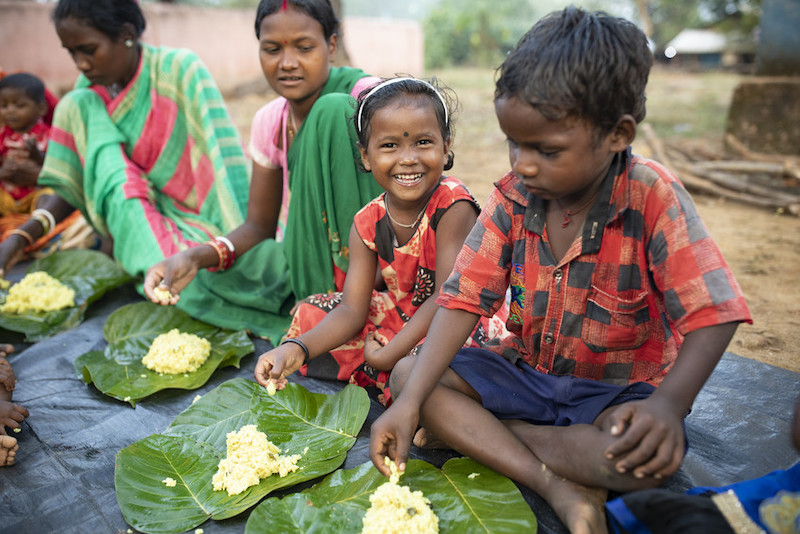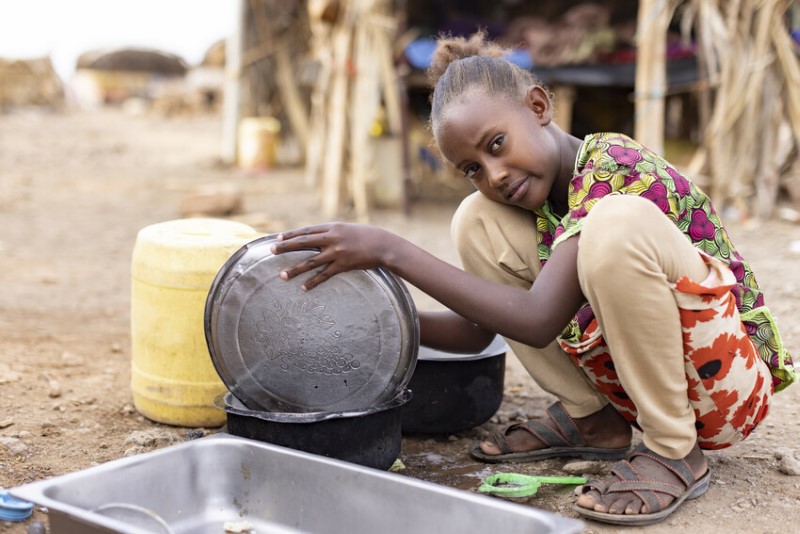
Kame, 9, washes dishes after a meal at her home in Marsabit County, Kenya. A record-breaking drought in East Africa has made food insecurity a near constant for her family.
If you’ve found yourself wincing at the prices you see in the grocery store lately, you’re not alone. People in the U.S. have been dealing with price hikes on our food – not to mention other essentials, like housing and fuel – for nearly a year. What we don’t often think about are the global effects of food inflation, especially on children. The rising price of food is a complex problem driven by everything from supply chain issues to government spending to higher wages and strong consumer demand. But, more than anything else, the COVID-19 pandemic caused a major setback in global poverty reduction that has had a ripple effect on the world’s economy. Now, rising food and energy prices, fueled by climate shocks and conflicts like the war in Ukraine, have halted the recovery, triggering a global crisis that is driving millions more into extreme poverty, magnifying hunger and malnutrition. We sat down with ChildFund experts in three countries – Sri Lanka, Kenya and Brazil – to talk about how food inflation affects kids in different parts of the world: Sandamali Rajapaksha has been ChildFund’s Program Specialist on Nutrition since 2007. She helps design and execute programs that boost children’s nutrition – especially under age 5, when they are most vulnerable to hunger and malnutrition.
Issa Kipera is the Program and Sponsorship Director for ChildFund Kenya. He helps design, plan and implement programs, plus oversee sponsorship activities with Kenya’s local partner organizations.
Cristiano Silva De Moura has worked with ChildFund Brazil for more than 20 years coordinating all kinds of programs to help children, most recently in the field of program monitoring and evaluation. He is also studying for his Ph.D. in Geography and Statistics. Read on to learn their thoughts on how soaring food prices impact children the most – and how you can help.
Tell us a little bit about how the global food crisis is impacting people in your country. How are children affected, in particular?
Sandamali: Sri Lanka is suffering from the worst economic crisis in the country’s history. We continue to experience high food inflation – the fifth-highest in the world, according to a recent World Bank report – along with rising commodity prices, power shortages and lack of fuel. In fact, the average monthly cost of a healthy diet has increased by 156 percent since 2018. Higher prices for food and other essentials, coupled with losses in income, are making it more and more difficult for families to afford their meals, so they are eating less and consuming cheaper, less nutritious food. This affects children in so many ways, and not just in terms of actual hunger. According to focus group discussions we’ve had within communities, child abuse cases are on the rise as parents and caregivers undergo increased stress about food. More children are being placed into state orphanages by families who are no longer able to provide for them. And children without parental care are especially vulnerable to harm. Girls are at particular risk of child marriage or forced marriage, early pregnancy, sexual exploitation and abuse, as well as dropping out of school. When food is scarce, girls and women often eat less and last. Issa: Kenya is facing a food crisis due to an increase in food prices. That increase has been driven by three key factors: the ongoing drought in our country, which has affected local production; an increase in the price of fuel, which has pushed up the costs of production and transportation; and the Russia-Ukraine war, which has adversely affected Ukraine’s ability to export foods we depend on here in Kenya, like maize, wheat and cooking oil. Of these, the drought is the most critical issue. For five years in a row, the 23 counties in the arid and semi-arid regions of Kenya have not received adequate rainfall. As a result, more than 4.2 million people are now in need of humanitarian assistance, mainly food and water, and hundreds of thousands of children are facing acute malnutrition. Just like Sandamali said, this food crisis actually leads to other issues like increased rates of child neglect, abuse and exploitation. Since caregivers are less able to provide for their children, some kids have been exposed to exploitation, including sexual exploitation, and harmful child labor. Physical and emotional abuse is also on the rise because families are stressed by the situation and struggling through mental breakdowns. Cristiano: First of all, it is important to explain what we mean by “food crisis.” Often, people think that if people have any food at all, they are not starving, and so there is no problem. But just because someone is not starving does not mean that they are not food insecure. Food insecurity can cause all kinds of problems, especially for children. When a child isn’t eating enough, or they’re not getting adequate nutrition from their food, the child’s physical and cognitive development is at risk. This was especially problematic during the COVID-19 pandemic. In Brazil, the vast majority of children living in poverty have their main meal at school. When COVID broke out, children lost access not only to their education, but also to the food that was provided at school. Now that most schools have reopened, meals are again being offered in school environments, but there are still limitations on the quantity and quality of foods served within homes. 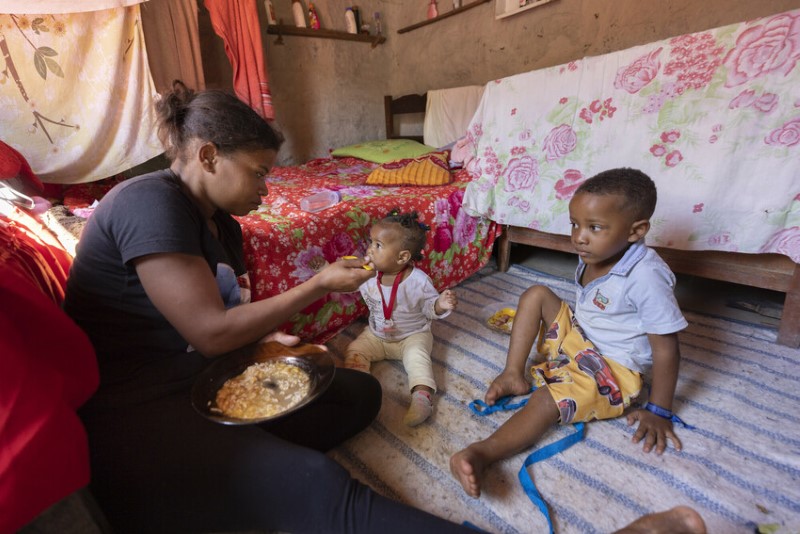
Isabela in Minas Gerais, Brazil, feeds lunch to her children, Isaac, 3, and Esther, 8 months. In just the last six months, the price of rice where she lives has doubled; meanwhile, the price of milk has tripled since the beginning of the pandemic. Fresh vegetables are too expensive to buy, so they’ve been relying on pumpkins they grow in the garden. “Food is our biggest worry,” Isabela says. “My daughter needs milk to drink, and I can’t afford it. We don’t eat meat very much, maybe just once a month. Things keep getting more expensive and more difficult. Only God can help us. If things get worse, we might starve.”
Do you know any children or families in our programs who are currently battling hunger, personally? How are they coping?
Sandamali: One family I know lives in the Siyabalanduwa area, where ChildFund has programs. There are two little boys in the family – a 5-year-old and a 3-year-old – and their father is a chronic kidney patient. They have always worked as farmers, but lately, because of the economic crisis, it has been difficult to afford the fertilizers and agrochemicals they need to farm successfully. So the boys have only been able to eat twice a day. Rice is so expensive here that the family typically only eats vegetables like manioc, yams, jackfruit and breadfruit. Animal products like fish, chicken and eggs are a luxury that the boys rarely get to see on the table. Neither of them have an appropriate weight for their age – they are both suffering from moderate acute malnutrition – and their mother has started working at a nearby sugar factory to help provide for them. Issa: One young child we have supported is a little girl named Kabale. She is 3 years old. Like many families in the arid region of Kenya, her family are pastoralists; they raise cattle for a living. But because of the drought, their herds began to die, leaving them without any income to buy food. Kabale was already facing severe acute malnutrition when we intervened. Her family was going two or three days between meals. Fortunately, ChildFund stepped in to provide a fortified porridge that helped her gain weight quickly and improve her health. The family has received supplementary food like maize meal, beans, cooking oil and rice, as well as emergency cash transfers, and they’re getting enough to eat now. But there are so many families like theirs, and I know the mother still worries about their long-term stability. About half their herds have died off, and she has little means of paying for school fees.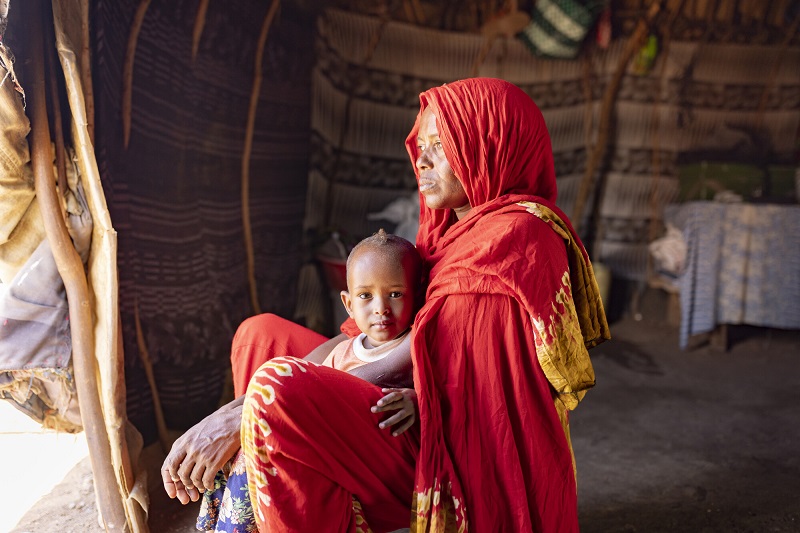
Kabale and her mom, Teso.
Cristiano: We have many cases of single mothers who do not have help from anyone else to earn an income. Unfortunately, many of these families live with hunger daily. The biggest problem is that the government’s financial benefits are not enough to guarantee adequate food for all, so families must struggle to seek other means of survival.
How is ChildFund’s program in your country supporting children through the food crisis?
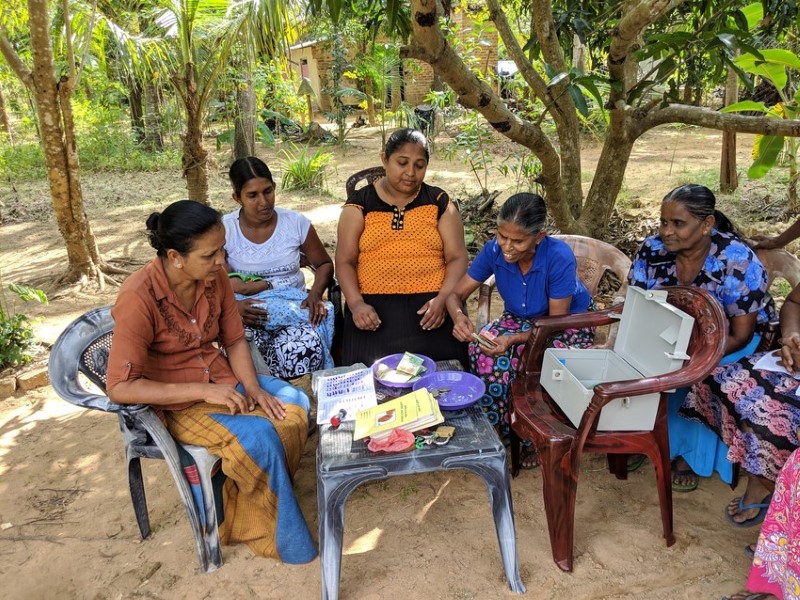
Mothers in ChildFund’s program near Puttalam, Sri Lanka, attend a meeting of their Village Savings & Loan group. The group, which meets twice a month, allows the women to save money together and grant loans to members in need – a powerful safety net for those facing food insecurity.
Sandamali: ChildFund Sri Lanka has designed something called Community Response Hubs, which focus on empowering communities to respond to their own needs and develop sustainable solutions that are deeply embedded in the local context. Through these hubs, community members themselves play a pivotal role in designing programs to address children’s most critical needs. One thing we’ve done to help prevent food insecurity is set up community kitchens throughout ChildFund’s program areas. Each community kitchen has an average of 100 participants, most of them families with children under age 5, and they gather three times a week in a central location to cook a protein-rich lunch together. ChildFund provides the bulk of the food, while the community provides the firewood and cooking utensils. There are currently 42 community kitchen programs, and around 2,600 children benefit from them. It is filling some critical gaps because these are some of the only times during the week when many children are getting a healthy, nutrient-rich meal.Issa: ChildFund Kenya supports families affected by the drought with cash transfers, food assistance and other non-food items. Specifically, in Marsabit, Isiolo, Samburu, Turkana, Kajiado and Kitui counties, we are reaching more than 4,000 families with cash transfers, school lunch programs, malnutrition screenings, access to clean and safe water, and animal feed.Cristiano: Within ChildFund's programs, we are able to ensure that no family goes hungry. The first thing we do is help families enroll in government benefit programs. This way, every registered family can receive a monthly allowance of 600 Brazilian reais, or about 20 reais (about $3.66 USD) per day. This is a low value, and if we consider areas with many residents, the per capita value lowers even more. Even so, it helps with access to food; it is not enough, but it helps. To receive this aid, all children must be attending school, which also contributes to giving the little ones more access to food. When necessary, ChildFund does work to donate food to the most vulnerable; however, our focus is on developing socioeconomic projects that can help families generate income in the long term – for example, poultry projects, production groups and a solidarity economy.
What, in your view, are the strongest tools we can use to fight child hunger in your country?
Sandamali: In terms of treating hunger, we need both short-term and long-term interventions. Our short-term interventions include planning activities to make sure children have access to food right now, through programs like the community kitchens. Kids who participate in community kitchens are gaining weight, demonstrating the program’s strength as a short-term tool. But we also need to think about the long-term. That’s why ChildFund Sri Lanka works to improve community awareness of children’s nutrition through our women’s groups, also called “Lead Mother” programs. In these programs, we help young mothers identify affordable, locally available nutritious foods to feed their children. We also support them to establish home and community gardens so that there are a wide variety of vegetables, fruits and grains available to meet children’s nutritional needs.Issa: The strongest way we can address child hunger is by building resilience in families. We can do this by adopting more sustainable, climate-smart farming methods, investing in children’s education and supporting youth to develop skills that will allow them to make a living in ways beyond subsistence farming. Cristiano: First, when we learn that a child is going hungry, we must meet their needs for nutritious food immediately, whether at home, school or both. But we don’t want to wait until this kind of emergency situation occurs. Rather, we must be proactive about supporting families to generate their own sustainable income – through education and professional job training. Sounds simple, doesn’t it? But it is not. Today, Brazil offers education to 100% of the population, but the quality of education is one of the worst on the planet. There is a huge discrepancy between the teaching offered by the private, federal, state and municipal systems; in other words, the problem is not just one of quality, but of inequality. In a similar way, the country has extreme difficulty in generating decent and quality jobs. These are not problems that can be solved overnight, but when we work together, we can find solutions.
How You Can Help a Child Facing Hunger
A child who is hungry can’t learn, play or just be a child. When you sponsor a child facing food insecurity, you can help them get the nutritious meals they need to grow up healthy and strong. They’ll have access to programs designed to improve their education and help them build the life skills they need to succeed in the long term. Best of all, sponsors always receive regular updates on their sponsored children’s progress – so you’ll be able to see the difference you’re making in their lives firsthand.Hunger hurts – and a food crisis always impacts children first. Become a sponsor and make sure a child has everything they need to thrive.